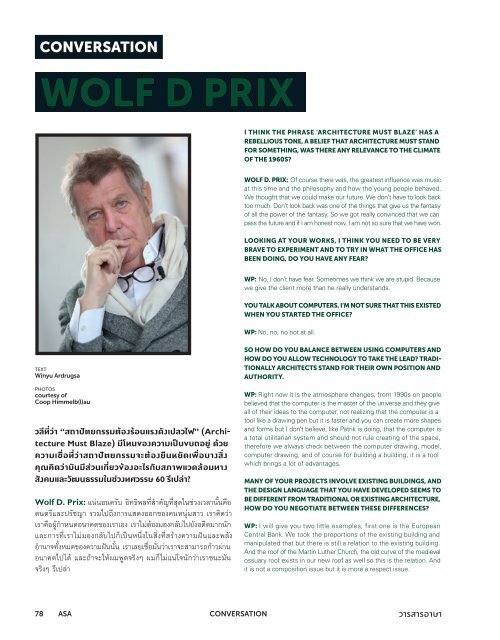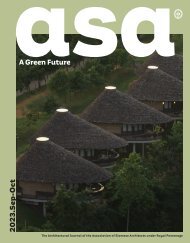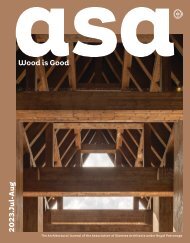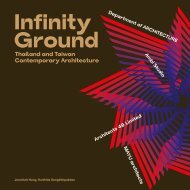ASA JOURNAL 06/59
You also want an ePaper? Increase the reach of your titles
YUMPU automatically turns print PDFs into web optimized ePapers that Google loves.
CONVERSATION<br />
WOLF D PRIX<br />
I THINK THE PHRASE ‘ARCHITECTURE MUST BLAZE’ HAS A<br />
REBELLIOUS TONE, A BELIEF THAT ARCHITECTURE MUST STAND<br />
FOR SOMETHING, WAS THERE ANY RELEVANCE TO THE CLIMATE<br />
OF THE 1960S?<br />
WOLF D. PRIX: Of course there was, the greatest influence was music<br />
at this time and the philosophy and how the young people behaved.<br />
We thought that we could make our future. We don’t have to look back<br />
too much. Don’t look back was one of the things that give us the fantasy<br />
of all the power of the fantasy. So we got really convinced that we can<br />
pass the future and if I am honest now, I am not so sure that we have won.<br />
LOOKING AT YOUR WORKS, I THINK YOU NEED TO BE VERY<br />
BRAVE TO EXPERIMENT AND TO TRY IN WHAT THE OFFICE HAS<br />
BEEN DOING, DO YOU HAVE ANY FEAR?<br />
WP: No, I don’t have fear. Sometimes we think we are stupid. Because<br />
we give the client more than he really understands.<br />
YOU TALK ABOUT COMPUTERS. I’M NOT SURE THAT THIS EXISTED<br />
WHEN YOU STARTED THE OFFICE?<br />
WP: No, no, no not at all.<br />
TEXT<br />
Winyu Ardrugsa<br />
PHOTOS<br />
courtesy of<br />
Coop Himmelb(l)au<br />
วลีที่ว่า “สถาปัตยกรรมต้องร้อนแรงดังเปลวไฟ” (Architecture<br />
Must Blaze) มีโทนของความเป็นขบถอยู่ ด้วย<br />
ความเชื่อที่ว่าสถาปัตยกรรมจะต้องยืนหยัดเพื่อบางสิ่ง<br />
คุณคิดว่ามันมีส่วนเกี่ยวข้องอะไรกับสภาพแวดล้อมทาง<br />
สังคมและวัฒนธรรมในช่วงทศวรรษ 60 รึเปล่า?<br />
Wolf D. Prix: แน่นอนครับ อิทธิพลที่สำคัญที่สุดในช่วงเวลำนั้นคือ<br />
ดนตรีและปรัชญำ รวมไปถึงกำรแสดงออกของคนหนุ่มสำว เรำคิดว่ำ<br />
เรำคือผู้กำหนดอนำคตของเรำเอง เรำไม่ต้องมองกลับไปยังอดีตมำกนัก<br />
และกำรที่เรำไม่มองกลับไปก็เป็นหนึ่งในสิ ่งที่สร้ำงควำมฝันและพลัง<br />
อำนำจทั้งหมดของควำมฝันนั้น เรำเลยเชื่อมั่นว่ำเรำจะสำมำรถก้ำวผ่ำน<br />
อนำคตไปได้ และถ้ำจะให้ผมพูดจริงๆ ผมก็ไม่แน่ใจนักว่ำเรำชนะมัน<br />
จริงๆ รึเปล่ำ<br />
SO HOW DO YOU BALANCE BETWEEN USING COMPUTERS AND<br />
HOW DO YOU ALLOW TECHNOLOGY TO TAKE THE LEAD? TRADI-<br />
TIONALLY ARCHITECTS STAND FOR THEIR OWN POSITION AND<br />
AUTHORITY.<br />
WP: Right now it is the atmosphere changes, from 1990s on people<br />
believed that the computer is the master of the universe and they give<br />
all of their ideas to the computer, not realizing that the computer is a<br />
tool like a drawing pen but it is faster and you can create more shapes<br />
and forms but I don’t believe, like Patrik is doing, that the computer is<br />
a total utilitarian system and should not rule creating of the space,<br />
therefore we always check between the computer drawing, model,<br />
computer drawing, and of course for building a building, it is a tool<br />
which brings a lot of advantages.<br />
MANY OF YOUR PROJECTS INVOLVE EXISTING BUILDINGS, AND<br />
THE DESIGN LANGUAGE THAT YOU HAVE DEVELOPED SEEMS TO<br />
BE DIFFERENT FROM TRADITIONAL OR EXISTING ARCHITECTURE,<br />
HOW DO YOU NEGOTIATE BETWEEN THESE DIFFERENCES?<br />
WP: I will give you two little examples, first one is the European<br />
Central Bank. We took the proportions of the existing building and<br />
manipulated that but there is still a relation to the existing building.<br />
And the roof of the Martin Luther Church, the old curve of the medieval<br />
ossuary roof exists in our new roof as well so this is the relation. And<br />
it is not a composition issue but it is more a respect issue.<br />
78 <strong>ASA</strong> CONVERSATION วารสารอาษา


















